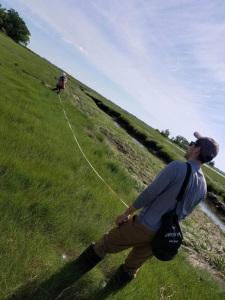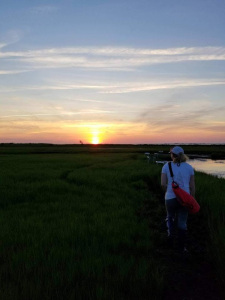 Imagine for a moment that you are a crab larva. Floating in the middle of an urban estuary (say, the Port of Rotterdam in the Netherlands), you just hatched, and are one of millions of little baby crabs hoping to survive long enough to make it to adulthood. Then suddenly, inexplicably, you are sucked up into a strong current that you don’t understand. The sun disappears, and you are surrounded by thousands of your brothers and sisters, but also many other larvae that you don’t recognize. Time seems to stand still, and you do what you can to make the best of a bad situation. Then suddenly, the same current again pulls you, but now in the opposite direction, back the way you came. Hooray, you are free! But wait, this new water feels different; this is not at all what you remembered of your home. By this time, you are a little older, a little larger, and a little bit more aware of your surroundings. You recognize you must be in a different place entirely, but you again make the best of a bad situation, and settle along the marshy shores of your new locale (not knowing you just entered Boston Harbor). You grow into an adult, and you discover to your relief that your home is not so bad after all. Predators don’t recognize you as prey, and parasites don’t infect you. So you yourself then reproduce, your offspring survive in massive numbers, and your species excels in this new home; a truly crabby paradise.
Imagine for a moment that you are a crab larva. Floating in the middle of an urban estuary (say, the Port of Rotterdam in the Netherlands), you just hatched, and are one of millions of little baby crabs hoping to survive long enough to make it to adulthood. Then suddenly, inexplicably, you are sucked up into a strong current that you don’t understand. The sun disappears, and you are surrounded by thousands of your brothers and sisters, but also many other larvae that you don’t recognize. Time seems to stand still, and you do what you can to make the best of a bad situation. Then suddenly, the same current again pulls you, but now in the opposite direction, back the way you came. Hooray, you are free! But wait, this new water feels different; this is not at all what you remembered of your home. By this time, you are a little older, a little larger, and a little bit more aware of your surroundings. You recognize you must be in a different place entirely, but you again make the best of a bad situation, and settle along the marshy shores of your new locale (not knowing you just entered Boston Harbor). You grow into an adult, and you discover to your relief that your home is not so bad after all. Predators don’t recognize you as prey, and parasites don’t infect you. So you yourself then reproduce, your offspring survive in massive numbers, and your species excels in this new home; a truly crabby paradise.
 Congratulations! You just experienced what it was like to be an invasive (i.e. non-native, non-indigenous, etc.) species transported from Europe to the Eastern United States by ballast water from a commercial vessel. In order to maintain buoyancy and pitch while at sea, ships take on various kinds of ballast including rocks and water. Rock ballast was more commonly used in early shipping in New England in the 17th, 18th, and 19th centuries. In fact, the first arrival of the European green crab Carcinus maenas to New England was through British and American merchants unloading rocks (which also contained crabs) at ports along the Gulf of Maine. A second wave of green crabs was introduced to the eastern seaboard more recently in the 1980s through water ballast (much like your own crab experience). Although seemingly beneficial for the crab, bioinvasions rapidly became a problem by the mid to late 1980s not only for native organisms, but also for people. In 1988, the zebra mussel was introduced accidentally to the Great Lakes in North America from Bulgaria in Europe. A fouling species of mussel that grows on practically any surface it touches, intake pipes from Lake Michigan to Chicago were clogged for weeks until utility companies were able to replace the critical infrastructure. The result: zebra mussels cost taxpayers millions to remediate the problem. Therefore, it is incredibly important to continue to understand global effects of bioinvasions on a variety of ecosystems including the Plum Island Estuary, and how to prevent their spread; no matter how much those crabs need a change of scenery!
Congratulations! You just experienced what it was like to be an invasive (i.e. non-native, non-indigenous, etc.) species transported from Europe to the Eastern United States by ballast water from a commercial vessel. In order to maintain buoyancy and pitch while at sea, ships take on various kinds of ballast including rocks and water. Rock ballast was more commonly used in early shipping in New England in the 17th, 18th, and 19th centuries. In fact, the first arrival of the European green crab Carcinus maenas to New England was through British and American merchants unloading rocks (which also contained crabs) at ports along the Gulf of Maine. A second wave of green crabs was introduced to the eastern seaboard more recently in the 1980s through water ballast (much like your own crab experience). Although seemingly beneficial for the crab, bioinvasions rapidly became a problem by the mid to late 1980s not only for native organisms, but also for people. In 1988, the zebra mussel was introduced accidentally to the Great Lakes in North America from Bulgaria in Europe. A fouling species of mussel that grows on practically any surface it touches, intake pipes from Lake Michigan to Chicago were clogged for weeks until utility companies were able to replace the critical infrastructure. The result: zebra mussels cost taxpayers millions to remediate the problem. Therefore, it is incredibly important to continue to understand global effects of bioinvasions on a variety of ecosystems including the Plum Island Estuary, and how to prevent their spread; no matter how much those crabs need a change of scenery!
– Michael Roy
Leave a Reply